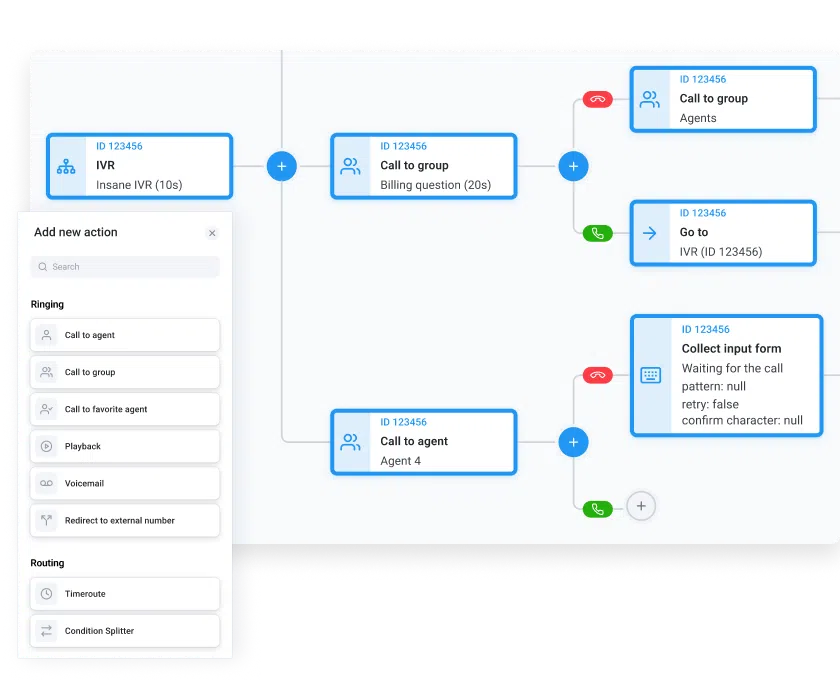7 Call Center Innovations: AI Trends and Tools
According to Gartner, 45% of employees claim AI improves productivity and efficiency*. If you’ve been on the fence about adopting AI, now’s the time to join the 46%* of leaders implementing AI in their organization. By leveraging AI technology, you can create an efficient, elevated customer service experience while saving time and money.
In this article, we’ll dive into the latest AI trends shaping the call center industry. We also explore leading tools and reveal how you can use AI to enhance customer satisfaction, streamline operations, and drive growth.
Key takeaways:
- AI tools provide efficient and personalized experiences: AI advancements like machine learning, natural language processing, and voice recognition allow call centers to automate routine processes while enhancing the quality of customer interactions.
- Predictive analytics and real-time insights drive better business decisions: AI-driven predictive analytics tools collect and analyze vast amounts of call data. This helps call centers anticipate trends, improve staffing strategies, and optimize customer service.
- CloudTalk’s AI-powered features streamline operations and boost productivity: CloudTalk offers features like Interactive Voice Response (IVR), which routes phone calls to the most appropriate service agents, and Smart Notes, which transcribes conversations and analyzes keywords. These tools reduce wait times and ensure that customers reach the right support without unnecessary transfers, enhancing the customer journey.
Improve customer interactions with CloudTalk
3 Current AI Trends in Call Centers
From deciphering language nuances to anticipating customer needs, AI trends are revolutionizing call centers, transforming the way they connect, serve, and thrive.
Let’s explore how.
Natural Language Processing (NLP)
NLP is a branch of artificial intelligence. It makes it possible for computers to understand, interpret, and respond to human language in a meaningful and contextually relevant way.
NLP enables AI capabilities like analyzing written or spoken language, translating texts, sentiment analysis, and conversational AI. This plays a big part in AI-enhanced customer experiences, making it possible to automate interactions while keeping things personalized.
One powerful NLP feature is Sentiment Analysis; it uses machine learning to analyze conversations between agents and customers. This way, it can determine whether the interaction is positive, negative, or neutral. This makes it easier to prioritize responses for certain customers, flag sensitive issues for human agents, and adjust messaging as needed.
NLP can also analyze large data sets in seconds, making it easier to glean valuable insights, identify patterns and trends, and make smart, data-driven decisions.
Chatbots and Virtual Assistants
When customers call in, it’s usually with a question or concern they’re hoping to get resolved quickly. They’re less concerned about how the issue is resolved than about the possibility of spending their precious time on hold indefinitely. A simple question may not require human intervention at all.
Chatbots and virtual assistants simulate human conversation through text or voice interactions. They use NLP and machine learning to understand and respond to user queries.
For voice-based interactions, they rely on automatic speech recognition (ASR) to convert spoken language into text. Chatbots can handle routine inquiries and tasks 24/7, giving call center agents time to work on higher-priority tasks.
Chatbots and virtual assistants can transform your call center operations by:
- Replicating human responses
- Delivering more natural, personalized customer interactions
- Interpreting complex questions
- Adapting to different communication styles
With AI at work, customer issues are resolved swiftly, offering a wider array of self-service options and boosting satisfaction levels. Generative AI goes further by analyzing customer behavior to anticipate potential problems so you can address them proactively.
Predictive Analytics
Call center analytics collects data from calls to monitor various performance metrics, like call durations and agent performance. Using advanced tools, it analyzes calls, predicts trends, and identifies opportunities for improvement. This can help you make better decisions around staffing and customer service.
For example, analytics might reveal a spike in customer calls about integration issues during product updates. With this powerful insight, your call center can proactively adjust staffing levels to meet demand, while also creating targeted educational resources to address recurring concerns. This lets you transform challenges into opportunities for exceptional service and efficiency.
The more data AI collects, the better it understands your business. Over time, this leads to customized insights and recommendations.
4 Crucial AI Tools for Call Centers
Not only does AI streamline operations, but it also delivers a better customer experience. 74% of call center agents agree that AI enhances customer satisfaction. Part of the reason for this is that AI has been shown to reduce call response times by up to 50%, increasing efficiency for clients and agents alike.
Let’s take a closer look at four essential AI tools and features of the best call center tech on the market.
Integrated AI Business Calling Software
AI Business calling software optimizes call handling with AI-powered features to streamline and enhance business communication.
These systems go beyond traditional phone systems by incorporating AI capabilities, such as advanced Call Routing, Real-Time Analytics, Transcription, and even Sentiment Analysis, all integrated into a single platform. This call center technology helps you handle customer calls efficiently, improve agent performance, and boost customer satisfaction through intelligent automation and insights.
For example, let’s say a customer becomes frustrated after being transferred multiple times. Sentiment Analysis detects a shift in tone and flags the call. The system notifies a senior agent to step in and resolve the situation before it escalates.
Key features of Integrated AI business calling software often include:
- Intelligent Call Routing: AI analyzes the caller’s history or context and routes them to the most qualified agent, reducing wait times and improving first-call resolution rates.
- Real-Time Transcription and Analytics: The software transcribes calls as they happen and analyzes them for insights like keyword tracking, Talk-Listen Ratio, and sentiment. This helps agents stay on track during calls and provides managers with actionable data.
- Sentiment Analysis: By detecting the customer’s mood or tone, AI can help agents respond more effectively, flag calls that may require special attention, or escalate issues as needed.
- CRM Integration: Integrated AI business calling software often syncs with CRM platforms, allowing agents to access relevant customer information instantly and personalize interactions.
- Post-Call Summary and Recommendations: AI can generate summaries of calls, highlighting key topics or issues discussed, and suggest follow-up actions. This makes it easier for agents to provide timely and accurate responses.
Note
💡Pro tip: Use Cloudtalk’s AI Smart Notes feature to enable speech-to-text conversion and transcribe conversations accurately. It also detects specific keywords and automates responses to common questions.
AI-Powered CRM Systems
CRMs often contain duplicate data, which prevents agents from getting a full picture of a customer’s profile.
These issues often go unnoticed until something goes wrong. Customer service takes a hit when a customer has to repeatedly update your team on the same problem. AI helps by spotting duplicate records and flagging them, so you can merge profiles with a single click.
Consider a call center for a retail company that regularly receives calls from customers inquiring about order status and returns.
Over time, multiple profiles are created for a single customer who calls with different order numbers or uses various communication channels. As a result, the CRM contains fragmented records for that one customer, with key details like previous complaints, loyalty status, and order history scattered across separate profiles.
Beyond merging duplicates, AI also categorizes interactions and analyzes voice transcripts in real time. For instance, it might flag a pattern of delayed shipments, enabling the team to prioritize calls on this issue. An AI-powered CRM equips your agents with insights to offer faster, more personalized customer support, leading to greater customer satisfaction and loyalty.
Speech Recognition Technology
Voice recognition technology enables AI systems to transcribe calls, interpret spoken language, and provide real-time insights into customer sentiment and behavior.
Tools like CloudTalk go beyond basic transcription by detecting customer sentiment, identifying key topics, and tracking Talk-Listen Ratios. This call center analysis helps customer service teams adjust responses based on a caller’s mood or concerns, leading to more effective and empathetic support.
Imagine receiving a sudden spike in calls about internet connectivity issues. CloudTalk’s Real-Time Transcription combined with its AI Trending Topics feature will quickly identify “connectivity issues” as a top trend within a matter of hours.
It works by detecting specific keywords—such as “slow internet,” “no connection,” and “network outage”—and analyzes customer sentiment, noting frustration or urgency in the callers’ tone.
With this information, your team can take immediate action. Agents receive alerts to prioritize connectivity-related calls and are primed to respond empathetically. Management can deploy a proactive message on social media and through SMS notifications, letting customers know they’re aware of the outage and working on a solution. This rapid, AI-powered insight allows you to address the issue at scale, reducing call volumes and frustration for customers awaiting updates.
Workforce Optimization Tools
AI-driven workforce optimization tools bring a new level of efficiency to scheduling, resource allocation, and routine tasks. By automating these areas, agents can focus on handling complex customer issues, which enhances productivity and reduces operational costs.For instance, AI can manage scheduling to adapt to fluctuating call volumes and workforce availability, ensuring resources align with demand. CloudTalk’s Interactive Voice Response (IVR) feature collects preliminary information and routes calls to the right agents, reducing wait times and misdirected calls.

Workflow Automation further streamlines operations by handling repetitive tasks like call routing, follow-up reminders, and data entry. This frees up agents to concentrate on delivering exceptional customer service rather than getting bogged down by routine processes.

Call recording is another valuable tool for workforce optimization, playing a key role in quality control, resolving misunderstandings, and protecting against potential disputes.
With CloudTalk’s Call Recording software, recordings and transcripts are generated and sent directly to designated team members’ inboxes. These recordings are invaluable for agent training. It lets your teams analyze what led to a successful sale or helped resolve a complex issue.
When paired with analytics tools, call recordings and transcripts become a goldmine of valuable insights. By analyzing which key phrases convert sales and identifying common customer pain points you can adjust scripts for maximum impact.
AI bots can handle 40-60% of customer service interactions
Embracing AI can transform your call center operations, increasing efficiency and providing valuable insights into customer needs. In fact, Deloitte found AI bots can handle 40-60% of customer service interactions related to business tasks without requiring human agents.
However, as you adopt AI technology, keep in mind the importance of human connection. Maintaining authentic, empathetic interactions is still at the heart of great customer service.
Striking the right balance means harnessing the advantages of AI while preserving the personal touch that fosters lasting customer loyalty.
CloudTalk makes it easy to find the right balance. Its AI features work with you to improve the customer experience, while giving every interaction the human attention it deserves to build customer relationships.
Get powerful insights from every call with CloudTalk AI
Sources
- Gallup. AI in the Workplace. 2024
- *Source of the statistic
FAQs About Call Center Innovation
What is an example of innovative call center technology?
One example is AI-driven speech analytics, which transcribes and analyzes customer conversations in real-time. This technology identifies customer sentiment, extracts key topics, and provides insights that help agents tailor responses. All of which helps to improve efficiency and customer satisfaction.
What are some innovations in customer service?
Customer service innovations include AI-powered chatbots for instant support, predictive analytics to anticipate customer needs, and omnichannel platforms that unify customer interactions across channels. These tools help streamline service, personalize experiences, and reduce wait times, enhancing overall customer satisfaction.





















